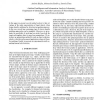Free Online Productivity Tools
i2Speak
i2Symbol
i2OCR
iTex2Img
iWeb2Print
iWeb2Shot
i2Type
iPdf2Split
iPdf2Merge
i2Bopomofo
i2Arabic
i2Style
i2Image
i2PDF
iLatex2Rtf
Sci2ools
77
Voted
ICMCS
2006
IEEE
2006
IEEE
Optimized Chamfer Matching for Snake-Based Image Contour Representations
In this paper we present a novel method on how to take advantage of the snake representation of target objects, when doing chamfer matching for detection/recognition purposes. In this case several time-consuming steps of classic chamfer matching approaches can be simplified. Moreover, we investigate the possibility of involving less pixels from both the target and template object to speed up computations. We introduce an optimization method for such an object reduction, which is valid also in the general application scheme of chamfer matching. Finally, we present our experimental results regarding human body detection.
| Added | 11 Jun 2010 |
| Updated | 11 Jun 2010 |
| Type | Conference |
| Year | 2006 |
| Where | ICMCS |
| Authors | András Hajdu, Athanasios Roubies, Ioannis Pitas |
Comments (0)

